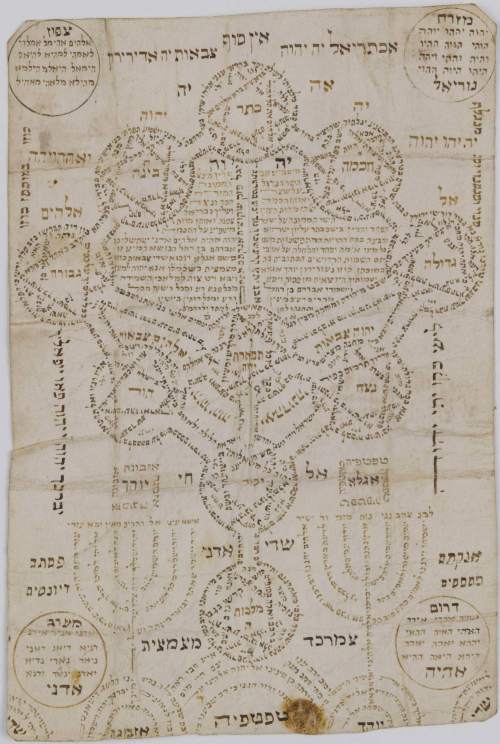Eco: The Kabbalistic Pansemioticism, 2
by Estéban Trujillo de Gutiérrez

Ilan Sefirot. Kabbalistic Divinity Map. Amsterdam, 18th century, NLI.
“In Christian tradition, the four levels are excavated through a labour of interpretation which brings surplus meaning to the surface. Yet it is a labour performed without altering the expression-plane, that is, the surface of the text.
The commentator tries in many ways to correct scribal errors, so as to re-establish the only and original version according to the alleged intention of the original author. For some kabbalistic currents, by contrast, to read means to anatomize, as it were, the very expression-substance, by three fundamental techniques: notariqon, gematria and temurah.
Notariqon was the technique of using acrostics to cipher and decipher a hidden message. The initial (or final) letters of a series of words generate new words. Such a technique was already a familiar artifice in poetry during the late antique and Middle Ages, when it was used for magic purposes under the name of ars notoria.
Kabbalists typically used acrostics to discover mystic relations. Mosé de Leon, for example, took the initial letters of the four senses of scripture (Peshat, Remez, Derash and Sod) and formed out of them PRDS.
Since Hebrew is not vocalized, it was possible to read this as Pardes or Paradise. The initial letters of Moses’s question in Deuteronomy 30:12, “Who shall go up for us to heaven?,” as they appear in the Torah form MYLH, or “circumcision,” while the final letters give YHWH, Jahveh.
The answer is therefore: “the circumcised will go up to God.” Abulafia discovered that the final letters of MVH (“brain”) and LB (“heart”) recall the initial letters of two Sefirot, Hokmah (wisdom) and Binah (intelligence).
Gematria was based on the fact that, in Hebrew, numbers are indicated by letters; this means that each Hebrew word can be given a numerical value, calculated by summing the numbers represented by its letters.
This allows mystic relations to be established between words having different meanings through identical numerical values. It is these relations that the kabbalist seeks to discover and elucidate.
The serpent of Moses, for example, is a prefiguration of the Messiah because the value of both words is 358. Adding up the letters in YHWH, we get 72, and kabbalistic tradition constantly searched for the seventy-two names of God.
Temurah is the art of anagrams. In a language in which vowels must be interpolated, anagrams are more exciting than in other idioms. Mosé Cordovero wondered why there appeared in Deuteronomy a prohibition against wearing garments of mixed wool and linen.
He found the answer when he discovered that the letters of that passage could be recombined to produce another text which warned Adam not to take off his original garment of light and put on the skin of the serpent, which symbolized demonic power.
Abraham Abulafia (thirteenth century) systematically combined the letter Alef with each of the four letters of the tetragrammaton YHWH; then he vocalized each of the resulting units by every possible permutation of five vowels, thus obtaining four tables with fifty entries each.
Eleazar ben Yudah of Worms went on to vocalize every unit using twice each of the five vowels, and the total number of combinations increased geometrically (cf. Idel 1988b: 22-3).”
Umberto Eco, The Search for the Perfect Language, translated by James Fentress, Blackwell. Oxford, 1995, pp. 27-8.
